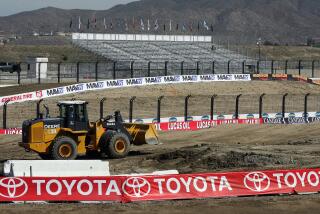Cycling Death Puts Helmets Under Scrutiny
A fatal crash at the Encino Velodrome on Saturday night has raised questions regarding safety requirements of bicycle track racing in Southern California.
Rod Ballard, 36, of Brentwood, suffered massive head injuries in the accident, which occurred during a match sprint race at the velodrome. He died Tuesday at Northridge Hospital Medical Center. According to track officials, Ballard was the first fatality at the 25-year-old velodrome.
Witnesses said Ballard flipped over his handlebars and landed on the track after his bike became entangled with the bike of another racer, Mark Garrett, of Los Angeles.
Attempts to reach Garrett, who reportedly finished ninth at the U.S. nationals last month in Indianapolis, were unsuccessful.
According to Paul Shecter, director of the Encino track, the racers were bumping as they competed in the three-lap sprint. “It’s a race of tactics and maneuveurs, and racers get close at high speeds,” he said. “There is no way to avoid it. There was contact.”
Shecter, who officiated the race with Bob Waite and Bob Enright, said he would have talked to both riders about the bumping after the race. “But I wouldn’t have disqualified anyone,” he added.
Larry Hoffman, who builds racing bikes, said that bumping often occurs in track racing. “In Europe, they bump a lot more,” he said. “Here, you’re not supposed to bump. Even if it’s accidental, you could get disqualified.”
During the race, Ballard, who had been racing professionally for three years, was wearing a leather helmet known as a “hair net.”
“They call it that because that’s about all it’s good for--holding your hair in place,” said Mark Rayner, who witnessed the crash. “It’s not nearly as safe as the hardshell (plastic or fiberglass) helmets.
“Rod used to wear a hardshell helmet. He wore one in races earlier this year. For some reason he switched to the hair net.”
Added Rayner, who also races at the track: “I started wearing a hardshell after seeing that. Something like that makes you see the light. I was wearing a hair net. It’s more fashionable among racers. But that doesn’t really seem to matter. . . .”
Traditionally, top cyclists rarely wear hardshell helmets, which are known in some racing circles as “brain buckets.”
“It’s very macho not to wear helmets over in Europe,” said John Lehrer, associate editor of Bicycle Rider Magazine. “They influence the Americans. I know racers who say if the Europeans started wearing hardshell helmets, they’d start wearing them tomorrow.
“The problem is, a lot of racers feel if other racers see them wearing a hardshell helmet then they think they’re scared. They doubt their bike-handling skills.”
Another problem, according to Lehrer, is that hair nets offer little protection. “When the head hits a hard object, the hair-net helmets don’t give the brain enough time to slow down,” he said. “They are worthless as far as real head protection goes. Any direct impact--forget it.”
According to U.S. Cycling Federation rules, hair-net helmets are permissible as protective headgear in sanctioned races. The rule allows racers to select their own helmet. It is the rider’s responsibility to pick equipment that will provide sufficient protection.
“Helmet safety is a continuing concern for the federation,” said Steven Ball, district representative of the USCF. “It is a topic of discussion. There’s a continuing process of evaluation and re-evaluation. We have a meeting coming up in a few weeks regarding the helmet issue.”
Regarding the growing concern over protection, Ball said: “At this point, the data is not conclusive. There’s nothing I’ve seen that proves that hardshell helmets are better than the traditional design--the hair net.”
In recent days, however, the track directors at the three velodromes in Southern California--located in Encino, Dominguez Hills and San Diego--have discussed a plan to encourage racers to wear hardshell helmets.
“It will be the racer’s decision,” said Shecter. “But they would get a partial refund of their entry fee if they wear a hardshell helmet all night long.”
But Shecter said the refund program could depend on what the USCF decides in its meetings at Colorado Springs, Colo., next month. “We hope they discuss our ideas,” he said.
Meanwhile, since the crash at Encino, according to one cyclist, hardshell helmet sales are up. “We enjoy the hell out of racing,” he said, “but now the danger factor is always on our mind.”
More to Read
Go beyond the scoreboard
Get the latest on L.A.'s teams in the daily Sports Report newsletter.
You may occasionally receive promotional content from the Los Angeles Times.










